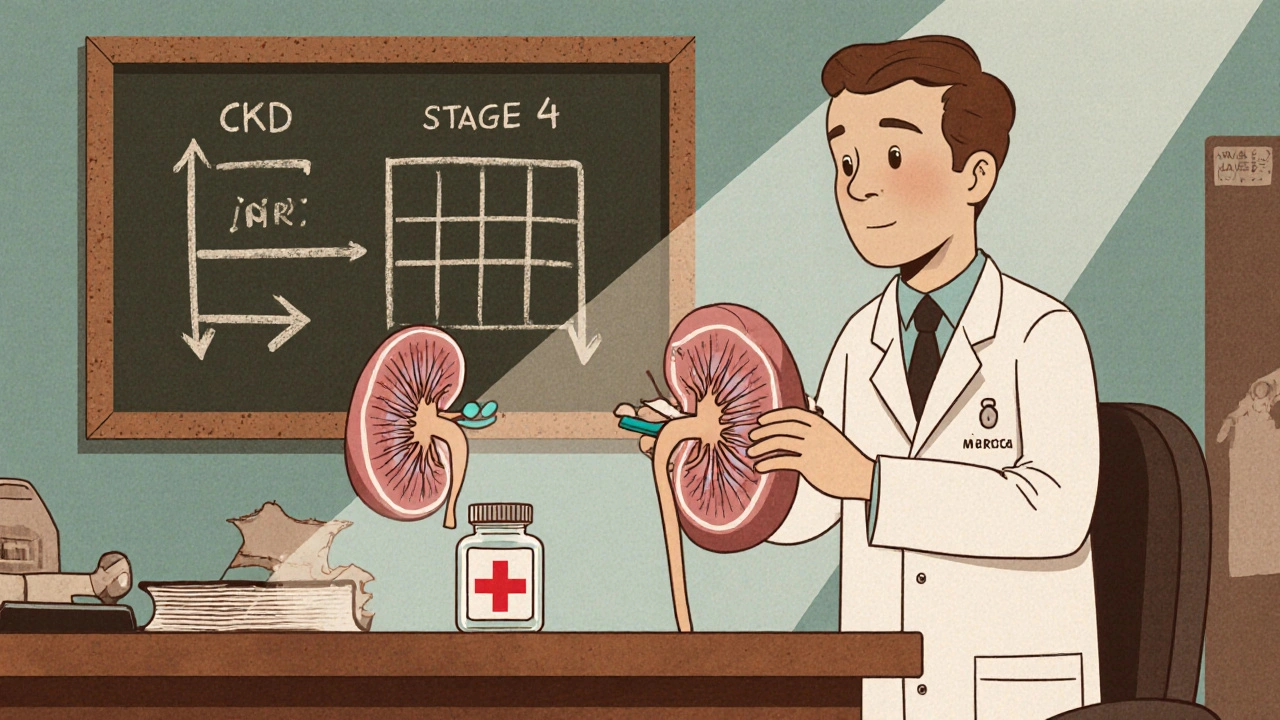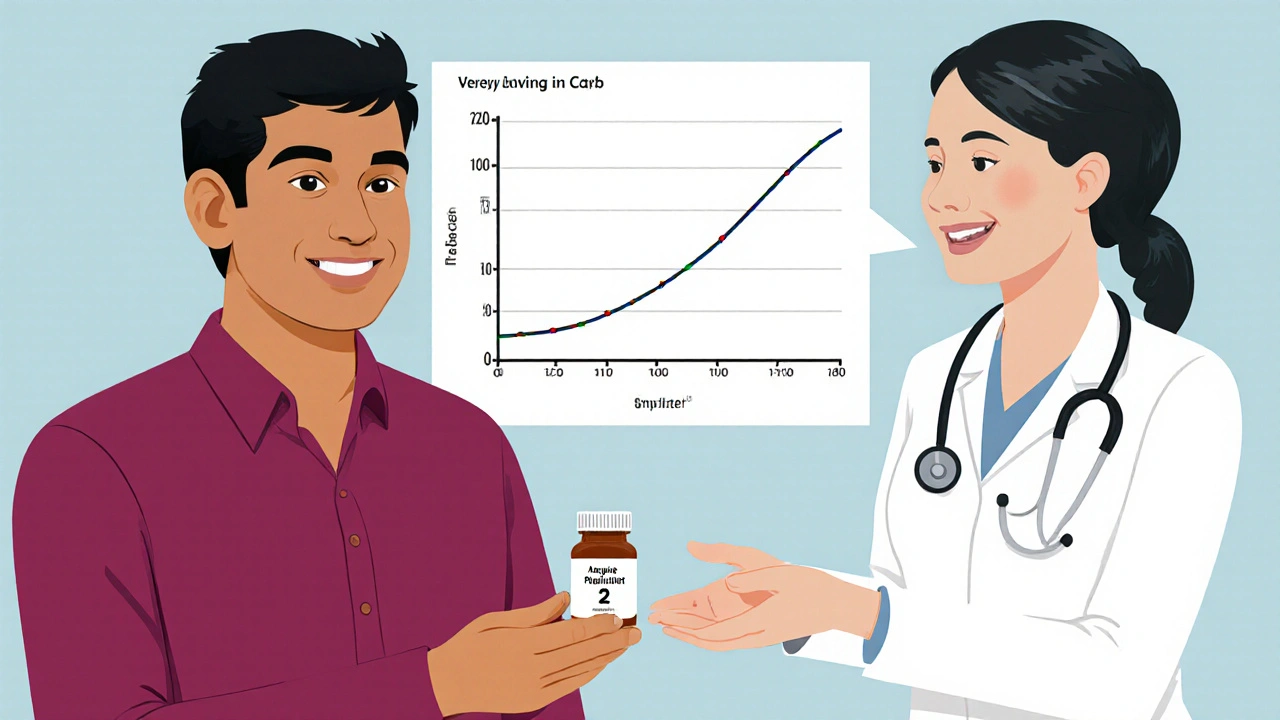Warfarin Use in Chronic Kidney Disease: A Practical Guide
 Oct, 26 2025
Oct, 26 2025
When treating patients with Warfarin is a long‑acting oral anticoagulant that works by inhibiting vitamin K‑dependent clotting factors. doctors must balance the drug’s life‑saving stroke prevention against the heightened bleeding risk that comes with impaired kidney function. warfarin dosing in chronic kidney disease (CKD) isn’t a one‑size‑fits‑all problem; it requires constant lab checks, dose tweaks, and a clear eye on drug interactions.
Understanding Chronic Kidney Disease and Why It Matters for Anticoagulation
Chronic Kidney Disease (CKD) is a progressive loss of renal function, usually measured by glomerular filtration rate (GFR). Stage 1 starts at a GFR of 90 mL/min/1.73 m², while Stage 5 (end‑stage renal disease) drops below 15 mL/min/1.73 m². As GFR falls, the body’s ability to clear drugs, metabolites, and protein‑binding partners changes dramatically.
Why does that affect anticoagulation? Warfarin is ~99 % protein‑bound, mainly to albumin. In CKD, albumin levels can dip, and uremic toxins compete for binding sites, altering the free (active) fraction of the drug. Moreover, CKD patients often have fluctuating vitamin K intake and may be on multiple medications that interfere with warfarin’s metabolism via the cytochrome P450 system, especially CYP2C9.
Key Pharmacokinetic Players in the CKD‑Warfarin Equation
- International Normalized Ratio (INR) is the lab readout used to gauge warfarin’s anticoagulant effect. Target INR varies by indication-usually 2.0‑3.0 for atrial fibrillation.
- Vitamin K intake directly opposes warfarin; dietary shifts can swing INR dramatically.
- Direct Oral Anticoagulants (DOACs) such as apixaban and rivaroxaban are often considered alternatives, but many are renally cleared and have their own dosing caveats in CKD.
- Cytochrome P450 (CYP2C9) metabolizes warfarin; inhibitors (e.g., amiodarone) raise plasma levels, while inducers (e.g., rifampin) do the opposite.
- Protein Binding changes in CKD affect the unbound warfarin fraction, influencing both efficacy and bleeding risk.
Initial Dosing Strategies: Start Low, Go Slow
Most guidelines suggest an initial warfarin dose of 2-5 mg daily for patients with GFR < 30 mL/min/1.73 m². The “low‑and‑slow” approach reduces the chance of overshooting the INR target during the first week.
Here’s a quick reference you can keep on your desk:
| CKD Stage | Typical GFR (mL/min/1.73 m²) | Starting Dose (mg/day) | Monitoring Frequency (first 2 weeks) |
|---|---|---|---|
| 3 | 30‑59 | 5 | Every 2‑3 days |
| 4 | 15‑29 | 3‑4 | Every 2 days |
| 5 (non‑dialysis) | <15 | 2‑3 | Every day |
| 5 (dialysis) | <15 (on dialysis) | 2‑3 | Every day |
Maintaining Therapeutic INR: Practical Tips
- Schedule regular INR checks. In CKD stages 4‑5, aim for at least twice‑weekly testing until the INR is stable for two consecutive readings.
- Keep a consistent vitamin K diet. Sudden leafy‑green meals can push INR down; a steady intake helps keep numbers predictable.
- Review all concurrent meds every visit. Look especially for CYP2C9 inhibitors (e.g., fluconazole, TMP‑SMX) and antibiotics that can spike INR.
- Adjust dose in 1‑mg increments. Larger jumps increase the odds of crossing the therapeutic window.
- Educate patients on signs of over‑anticoagulation (easy bruising, blood in urine, prolonged nosebleeds) and under‑anticoagulation (new swelling, chest pain).
When to Consider Switching to a DOAC
Direct oral anticoagulants have predictable pharmacokinetics and don’t require routine INR monitoring, but many are cleared renally. Below is a quick rule‑of‑thumb:
- Apixaban: dose reduction at GFR < 30 mL/min; still preferred over warfarin in many CKD 4 patients because bleeding risk is lower.
- Rivaroxaban & edoxaban: avoid if GFR < 15 mL/min.
- Dabigatran: contraindicated in GFR < 30 mL/min.
If a patient is already on warfarin and struggling with INR swings, a switch to apixaban (with dose adjustment) may simplify care. However, remember that dialysis patients often still need warfarin because DOAC data are limited.

Avoiding Common Pitfalls
Pitfall 1: Ignoring fluid shifts. Hospitalized CKD patients may receive IV fluids that dilute plasma proteins, temporarily increasing free warfarin and causing a sudden INR rise.
Pitfall 2: Assuming stable dosing after three readings. CKD progression can be non‑linear; revisit the dose whenever GFR changes by >5 mL/min.
Pitfall 3: Over‑reliance on point‑of‑care INR devices. While handy, they can be less accurate at extremes of INR, which are precisely the values you fear in CKD.
Case Study: Mr. Patel, 68‑Year‑Old with Stage 4 CKD
Mr. Patel was diagnosed with atrial fibrillation and a GFR of 22 mL/min/1.73 m². His baseline INR was 1.0. The clinician started warfarin at 3 mg daily and ordered INR on day 2, 4, and 7. Day 4 read 2.1, day 7 2.9-still within target. A week later, he began a five‑day course of trimethoprim‑sulfamethoxazole for a urinary infection. INR spiked to 4.5, prompting a temporary hold of warfarin and vitamin K administration. After the antibiotic finished, the INR fell back to 2.4, and his dose was reduced to 2 mg daily.
This vignette illustrates the need for close monitoring during any medication change, especially antibiotics that affect CYP2C9.

Quick Checklist for Busy Clinicians
- Assess CKD stage (use recent eGFR).
- Start warfarin at 2‑5 mg depending on stage.
- Check INR within 48 hours of the first dose, then every 2‑3 days until stable.
- Document vitamin K intake and adjust diet advice.
- Review all concurrent meds for CYP2C9 interactions.
- Consider apixaban if INR control proves difficult and GFR > 15 mL/min.
- Re‑evaluate dose whenever GFR changes by >5 mL/min.
Frequently Asked Questions
Can warfarin be used safely in patients on dialysis?
Yes, but it requires tighter INR surveillance-often weekly-because dialysis can remove small amounts of vitamin K and alter protein binding. Dose usually starts at 2‑3 mg and is titrated slowly.
What is the target INR for atrial fibrillation in CKD?
Most guidelines recommend 2.0‑3.0. Some experts suggest staying at the lower end (2.0‑2.5) for Stage 4‑5 CKD to reduce bleeding risk.
How often should the INR be checked after the dose is stable?
In stable CKD 3 patients, every 4‑6 weeks is typical. For CKD 4‑5, keep it at every 2‑4 weeks even after stability.
Are there any dietary supplements that interact with warfarin in CKD?
Yes. High‑dose fish oil, garlic tablets, and ginkgo can increase bleeding risk. Vitamin K‑rich supplements (like kale powders) can lower INR. Always review any over‑the‑counter product.
When should a clinician switch from warfarin to a DOAC?
If INR control is erratic despite dose adjustments, if the patient is on many CYP2C9 inhibitors, or if the patient prefers fewer lab visits and has a GFR > 15 mL/min, a switch-most often to apixaban-may be justified.
By treating warfarin dosing as a dynamic process that follows kidney function, clinicians can keep patients protected from both clotting and bleeding. The key is frequent labs, awareness of drug‑drug interactions, and a willingness to pivot to newer anticoagulants when the balance tips.

Holly Kress
October 26, 2025 AT 18:24Balancing warfarin's benefits against bleeding risk in CKD truly feels like walking a tightrope. The guide's emphasis on frequent INR checks is spot‑on for safety. Remember to reassess the dose whenever GFR shifts by more than five units – it can make a real difference. Thanks for laying out the dosing tables so clearly.
Chris L
November 9, 2025 AT 06:24Great summary! I appreciate the reminder that protein binding changes can tilt the INR unexpectedly. Keeping an eye on vitamin K intake and CYP2C9 inhibitors makes the whole process smoother. Your practical tips will help us avoid a lot of trial‑and‑error.
Charlene Gabriel
November 22, 2025 AT 18:24Warfarin remains a cornerstone for stroke prevention in patients with atrial fibrillation, even when kidney function declines, yet its management becomes increasingly nuanced as chronic kidney disease progresses. The fact that warfarin is 99 % protein‑bound means that hypoalbuminemia common in CKD can raise the free fraction, prompting a higher anticoagulant effect at a given dose. Moreover, uremic toxins compete for albumin binding sites, further destabilizing the pharmacokinetic profile and making INR swings more frequent. Starting doses of 2–5 mg daily, as the guide recommends, align with the principle of “start low, go slow,” reducing the risk of overshooting the therapeutic window during the first week. Frequent INR monitoring-every two to three days for CKD stage 3, and every day to two days for stage 4-allows clinicians to catch these fluctuations before they translate into bleeding events. Vitamin K intake can be a silent driver of variability; even modest changes in leafy‑green consumption may shift the INR by 0.5 to 1.0 units. The guide wisely points out that drugs like amiodarone, which inhibit CYP2C9, can double warfarin levels, while inducers such as rifampin can have the opposite effect, demanding dose adjustments. In patients on dialysis, the removal of vitamin K during the procedure can create a temporary hyper‑coagulable state, underscoring the need for tighter INR surveillance. When GFR drops below 15 mL/min, many providers consider switching to apixaban, but the evidence remains mixed and renal dosing rules must be obeyed. The recommendation to keep the target INR at the lower end of the 2.0–3.0 range for stages 4 and 5 is prudent, as it mitigates bleeding while still offering protection against embolic stroke. Dietary supplements, especially high‑dose fish oil, garlic, and ginkgo, are notorious for potentiating warfarin’s effect and should be reviewed at each visit. The table summarizing initiation doses by CKD stage serves as a quick bedside reference, which can be printed and stuck on a whiteboard for busy clinicians. Re‑evaluating the dose whenever GFR changes by more than five units ensures that the regimen remains aligned with renal clearance capacity. Finally, patient education about consistent vitamin K intake and medication adherence cannot be overstated, as patient‑driven variability often eclipses provider‑controlled factors. Overall, treating warfarin dosing as a dynamic, kidney‑function‑linked process is the best strategy to safeguard patients from both clotting and bleeding complications.
Leah Ackerson
December 6, 2025 AT 06:24Warfarin in CKD is a delicate alchemy; you must balance the scales of clot and bleed, lest you tip into chaos 🌪️. The interplay of protein binding and uremic toxins feels like a philosophical riddle where the answer shifts daily 🧩. Remember, every dose adjustment is a meditation on mortality and the fragility of homeostasis. Keep your patients' vitamin K intake steady, and treat each INR reading as a mantra guiding your next move.